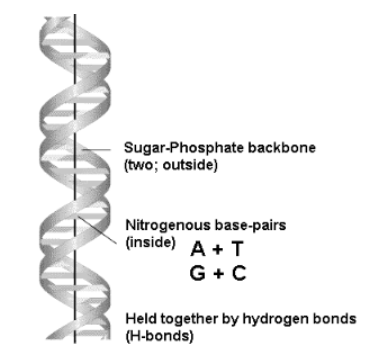DNA is a helical, double-stranded molecule with two strands. On the surface, it has two backbones (with alternating glycosyl and phosphate groups) that are linked together on the inside by hydrogen bonds between pairs of nitrogenous bases.
The bases are divided into four categories (A, C, G, and T), with A & T and C & G always matching.
James Watson and Francis Crick realised that these pairing principles indicated that either strand held all the information needed to build a new copy of the complete molecule and that the aperiodic sequence of bases might offer a “genetic code”.
History
- Linus Pauling, in 1925, utilised X-ray crystallography to determine the secondary structure of proteins. X-ray crystallography was used for analysing molecular structure. One could see the patterns produced by the X-rays when they were shot through the crystal of a material.
- The patterns revealed important details about the structure of any molecule of interest.
- In 1953, Rosalind Franklin, a researcher at Wilkins Lab in the US, used X-ray crystallography to explore the structure of DNA.
- In the 1950s, while working together at Cambridge, England, Watson and Crick were able to piece together the jigsaw of the DNA molecule using Franklin’s discoveries.
Watson-Crick Structure of DNA
- Watson and Crick presented a model for the DNA’s double-helix structure.
- A nucleotide polymer makes up the DNA molecule.
- A nitrogenous base, a five-carbon sugar (deoxyribose), and a phosphate group are found in each nucleotide.
- There are two purines (adenine and guanine) and two pyrimidines in the DNA (cytosine and thymine).
- Two strands of DNA make up a DNA molecule.
- Each strand is made up of nucleotides that are covalently linked by their phosphate groups and deoxyribose sugars.
- The bases grow out of this backbone.
- Hydrogen bonds connect the bases of strands.
- Adenine is always linked with thymine, while cytosine is always linked with guanine.
Given below is the diagram for the Watson-Crick Structure Of DNA

- The two strands wrap around each other in a shape termed the ‘double helix’ because of the bonding.
- The second nucleic acid found in the cells is ribonucleic acid (RNA). RNA is a nucleotide polymer with a single strand.
- It also contains sugar ribose instead of deoxyribose and nucleotide uracil instead of thymine.
- RNA molecules play a role in the formation of proteins using DNA’s genetic code.
- Prokaryotes have a single circular chromosome with double strands.
- Eukaryotes have chromosomes that include double-stranded linear DNA molecules.
- Nucleosomes are formed when the DNA helix wraps around proteins.
- Protein coils get progressively more coiled, and the chromosomes become even more coiled throughout mitosis and meiosis to make movement easier.
- Chromosomes feature two unique regions that may be differentiated by staining and are determined by whether the DNA in a region is expressed (euchromatin) or not (heterochromatin).
Features of the Watson-Crick Structure of DNA
The Watson-Crick model of DNA has the following important characteristics:
- In a DNA molecule, a right-handed double-helix is made up of a series or strands of two polynucleotides spirally wrapped around each other and twisted along a common path.
- The two strands run in opposing directions, with the fifth ending of one chain facing the third ending of the other. In other words, they are antiparallel.
- The sugar-phosphate backbones remain on the exterior, while the purines and pyrimidines bases are located at the centre of the helix.
- The two series are kept together by hydrogen bonds formed between the purines and pyrimidine bases of the opposing strands.
- Adenine (A) will always couple with thymine (T) through two hydrogen interactions, while guanine (G) will always pair with cytosine (C) via three hydrogen bonds. This complementary nature is known as the rule of the base pair. As a result, the two chains are complementary to each other.
- The base sequence varies throughout a polynucleotide chain. A certain sequence of bases carries genetic information.
- The constitution of the base of the DNA follows Chargaff’s assumptions (E.E. Chargff, 1950), according to which A = T and G = C. As a corollary, ∑ purines (A+G) = ∑ pyrimidines (C + T). Also, (A + C) = (G + T). The rules also put forth the ratio of (A + T) and (G + C) as constants for a species (range 0.4 to 1.9).
- The DNA has a diameter of 20 nm, or 20Å. The adjoining bases are 0.34 nm or 3.4Å along the axis apart. The length of a full helix turn is 3.4 nm or 34Å, implying that there are 10b/turning.
- A small groove, called the minor groove (1.2 nm), and a deep groove, known as the major groove (2.2 nm), run across the DNA helix.
Conclusion
Watson and Crick postulated the “double helix” molecular structure of the DNA. The precise pairing of nucleotides is a critical aspect of the Watson and Crick model of DNA. Each DNA strand, in this case, is linear and long and is made up of smaller units known as nucleotides that link together to form a chain.
Also check:
 Profile
Profile Settings
Settings Refer your friends
Refer your friends Sign out
Sign out






